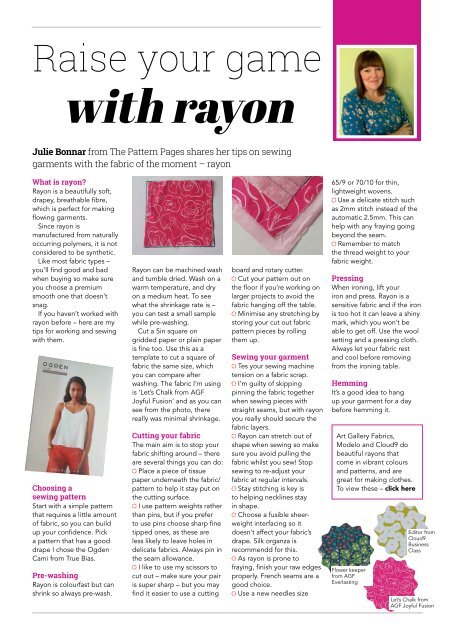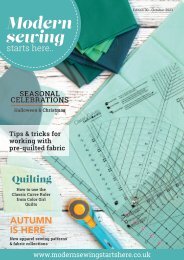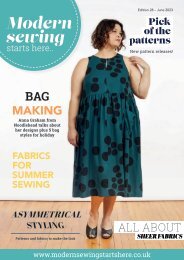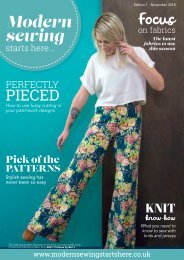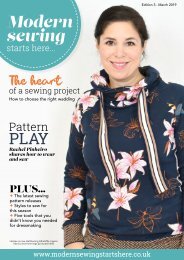Modern Sewing Starts Here Edition 5
Modern Sewing Starts Here is the digital publication which features articles, reviews and handy tips for anyone with an interest in contemporary sewing This month we bring you: Pick of the latest sewing patterns Incorporate the Scarf Print Trend In Sewing Trendsetter - add style to your creations Organise Your Sewing Space Free motion Quilting Tips Sewing With Rayon + much more ...
Modern Sewing Starts Here is the digital publication which features articles, reviews and handy tips for anyone with an interest in contemporary sewing
This month we bring you:
Pick of the latest sewing patterns
Incorporate the Scarf Print Trend In Sewing
Trendsetter - add style to your creations
Organise Your Sewing Space
Free motion Quilting Tips
Sewing With Rayon
+ much more ...
You also want an ePaper? Increase the reach of your titles
YUMPU automatically turns print PDFs into web optimized ePapers that Google loves.
Raise your game<br />
with rayon<br />
Julie Bonnar from The Pattern Pages shares her tips on sewing<br />
garments with the fabric of the moment – rayon<br />
What is rayon?<br />
Rayon is a beautifully soft,<br />
drapey, breathable fibre,<br />
which is perfect for making<br />
flowing garments.<br />
Since rayon is<br />
manufactured from naturally<br />
occurring polymers, it is not<br />
considered to be synthetic.<br />
Like most fabric types –<br />
you’ll find good and bad<br />
when buying so make sure<br />
you choose a premium<br />
smooth one that doesn’t<br />
snag.<br />
If you haven’t worked with<br />
rayon before – here are my<br />
tips for working and sewing<br />
with them.<br />
Choosing a<br />
sewing pattern<br />
Start with a simple pattern<br />
that requires a little amount<br />
of fabric, so you can build<br />
up your confidence. Pick<br />
a pattern that has a good<br />
drape I chose the Ogden<br />
Cami from True Bias.<br />
Pre-washing<br />
Rayon is colourfast but can<br />
shrink so always pre-wash.<br />
Rayon can be machined wash<br />
and tumble dried. Wash on a<br />
warm temperature, and dry<br />
on a medium heat. To see<br />
what the shrinkage rate is –<br />
you can test a small sample<br />
while pre-washing.<br />
Cut a 5in square on<br />
gridded paper or plain paper<br />
is fine too. Use this as a<br />
template to cut a square of<br />
fabric the same size, which<br />
you can compare after<br />
washing. The fabric I’m using<br />
is ‘Let’s Chalk from AGF<br />
Joyful Fusion’ and as you can<br />
see from the photo, there<br />
really was minimal shrinkage.<br />
Cutting your fabric<br />
The main aim is to stop your<br />
fabric shifting around – there<br />
are several things you can do:<br />
Place a piece of tissue<br />
paper underneath the fabric/<br />
pattern to help it stay put on<br />
the cutting surface.<br />
I use pattern weights rather<br />
than pins, but if you prefer<br />
to use pins choose sharp fine<br />
tipped ones, as these are<br />
less likely to leave holes in<br />
delicate fabrics. Always pin in<br />
the seam allowance.<br />
I like to use my scissors to<br />
cut out – make sure your pair<br />
is super sharp – but you may<br />
find it easier to use a cutting<br />
board and rotary cutter.<br />
Cut your pattern out on<br />
the floor if you’re working on<br />
larger projects to avoid the<br />
fabric hanging off the table.<br />
Minimise any stretching by<br />
storing your cut out fabric<br />
pattern pieces by rolling<br />
them up.<br />
<strong>Sewing</strong> your garment<br />
Tes your sewing machine<br />
tension on a fabric scrap.<br />
I’m guilty of skipping<br />
pinning the fabric together<br />
when sewing pieces with<br />
straight seams, but with rayon<br />
you really should secure the<br />
fabric layers.<br />
Rayon can stretch out of<br />
shape when sewing so make<br />
sure you avoid pulling the<br />
fabric whilst you sew! Stop<br />
sewing to re-adjust your<br />
fabric at regular intervals.<br />
Stay stitching is key is<br />
to helping necklines stay<br />
in shape.<br />
Choose a fusible sheerweight<br />
interfacing so it<br />
doesn’t affect your fabric’s<br />
drape. Silk organza is<br />
recommendd for this.<br />
As rayon is prone to<br />
fraying, finish your raw edges<br />
properly. French seams are a<br />
good choice.<br />
Use a new needles size<br />
65/9 or 70/10 for thin,<br />
lightweight wovens.<br />
Use a delicate stitch such<br />
as 2mm stitch instead of the<br />
automatic 2.5mm. This can<br />
help with any fraying going<br />
beyond the seam.<br />
Remember to match<br />
the thread weight to your<br />
fabric weight.<br />
Pressing<br />
When ironing, lift your<br />
iron and press. Rayon is a<br />
sensitive fabric and if the iron<br />
is too hot it can leave a shiny<br />
mark, which you won’t be<br />
able to get off. Use the wool<br />
setting and a pressing cloth.<br />
Always let your fabric rest<br />
and cool before removing<br />
from the ironing table.<br />
Hemming<br />
It’s a good idea to hang<br />
up your garment for a day<br />
before hemming it.<br />
Art Gallery Fabrics,<br />
Modelo and Cloud9 do<br />
beautiful rayons that<br />
come in vibrant colours<br />
and patterns, and are<br />
great for making clothes.<br />
To view these – click here<br />
Flower keeper<br />
from AGF<br />
Everlasting<br />
Editor from<br />
Cloud9<br />
Business<br />
Class<br />
Let’s Chalk from<br />
AGF Joyful Fusion


